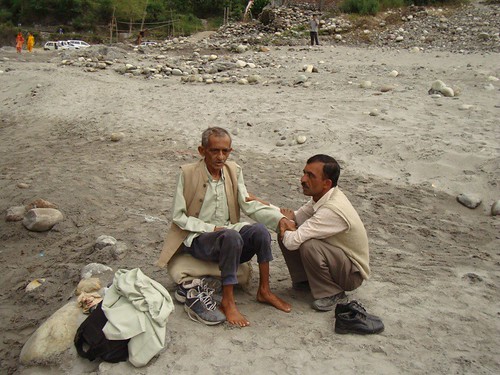
So - to continue from where the last post left off - I'm just back from a short summer break on the blissfully cool slopes of the lower Himalayas.
Naldhera - Abode of God - is 2500 metres above sea level, and a six hour drive from
Chandigarh. It is about an hour away from
Simla, the capital of Himachal Pradesh.
.We took a late morning flight to Chandigarh, so we got there when the sun was high in the sky. The heat hit us like a furnace when we got off the plane. The tarmac was hot and dry and blindingly white as we walked towards the airport building to collect our bags. When we got outside the airport building, there was construction everywhere - the place looked like a disaster zone. To add to it, the May heat rose off the newly set concrete in dizzying waves.
.Ranjit Singh, our young Sikh driver, was not apologetic - he waved at the mess and told us very matter-of-factly that they're converting Chandigarh to an international terminal. I have only one piece of advice for the Chandigarh airport authorities: Plant lots of trees! Your international visitors will need the shade!!
In direct contrast, Naldhera was blissfully cool. When we got there it was dark, so it was only the next morning that I figured out how beautiful the place was.
.I sat and listened to birdsong at 6:00 a.m. The trees rose behind the cottage, tall and straight, everything around me was serene and perfect. (Well, almost perfect. By seven thirty, the enlightened management of
Chalets Naldhera were piping some very irritating outdoor music on a tinny music system. Can you imagine ruining the peace of this place with bad music?)
The very first thing we did was go on a trek to explore the cedar and pine forests around us. The forest floor was crunchy-soft with needles, and the climb was surprisingly steep. We were rewarded with a view of the Sutlej River as it rushed down below, muddy and swirling with the silt from the upper slopes.
"There are hot springs down there, Madam", said our guide Raju. .
.
"Where?", I asked. .
.
"Tatta Pani", he said. "It's down there. Very holy place."
.

I'd never even heard of Tatta Pani, but it sounded interesting. So the next day, we decided to check it out. Tatta Pani, it turns out, is a little village on the banks of the Sutlej. And "tatta" is localspeak for "tapta" - boiling. Tapta Pani. Very poetic. Conjures up bubbling hot water, doesn't it?
We drove about an hour from Naldhera to get to Tatta Pani. The hot sulphur springs right next to the river were an interesting sight, especially because the Sutlej itself is so cold.
The kids had a great time jumping from hot water into cold, and from cold into hot. But Tatta Pani is not all about fun. It is also famous for its curative properties.
We saw a hopeful family of three - an ailing old man and two of his sons. They were at Tatta Pani, trying to curing their father of a sickness that had left him feeble and unable to walk.
.
Something about these three arrested my attention - maybe it was the fact that they were so silent. None of them really spoke much, but the sons were attentive and considerate. One son held his father's hand, while the other son made a little private pool for him to bathe. When the bath was over, they offered prayers assisted by a local priest.

Here's the other brother, creating a little impromptu spa. The water was hot, so every now and then, he would dip his hands into the cold river water flowing nearby. Since the going was slow, both brothers joined forces to dig out the pool. They gave each other quiet instructions, and used sticks and stones. I watched them hunched over the sand, patting down mud and stones, and marvelled at how it was both a labour of love and an expression of simple, abiding faith. I was glad I went to Tatta Pani.

Tatta Pani gets crowded in Jan-Feb (the month of Magha), when large numbers of people come to bathe in the waters. They believe that a dip in this water will wash away all their sins. They also visit the old Shiva cave temple nearby. Another busy day is Baisakhi Day in April.
(Funnily, locals also come here on January 26th, Republic Day, I'm not sure why! Sometimes I think I will never understand this country of mine)
For more tales of Naldhera and Tatta Pani, and my little shopping expedition to Simla, check out my flickr photo travelogue.
 Everyone knows about the Masai of Africa, but have you heard of the Lion People of Gujarat?
Everyone knows about the Masai of Africa, but have you heard of the Lion People of Gujarat? The Forest Department believes Maldhari cattle over-graze the forest, making life difficult for the deer, nilgai and other ungulates of Gir. And domestic cattle can bring disease into the forest, wiping out the last surviving pure breed of Asiatic lions.
The Forest Department believes Maldhari cattle over-graze the forest, making life difficult for the deer, nilgai and other ungulates of Gir. And domestic cattle can bring disease into the forest, wiping out the last surviving pure breed of Asiatic lions.
 So - to continue from where the last post left off - I'm just back from a short summer break on the blissfully cool slopes of the lower Himalayas.
So - to continue from where the last post left off - I'm just back from a short summer break on the blissfully cool slopes of the lower Himalayas.

